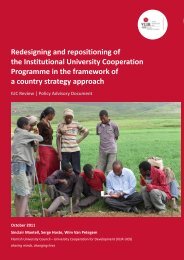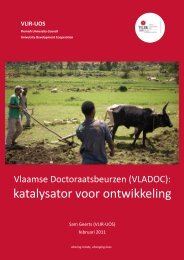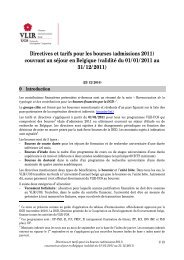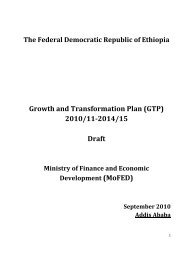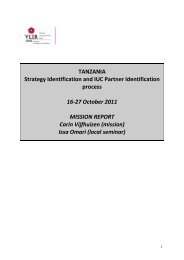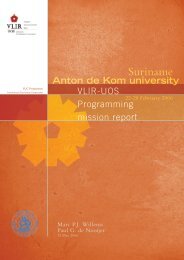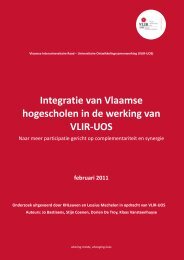Education Sector Development Program - VLIR-UOS
Education Sector Development Program - VLIR-UOS
Education Sector Development Program - VLIR-UOS
Create successful ePaper yourself
Turn your PDF publications into a flip-book with our unique Google optimized e-Paper software.
<strong>Education</strong> <strong>Sector</strong> <strong>Development</strong> <strong>Program</strong> IV<br />
Identify named focal person in each region to lead<br />
EiE planning and preparation activities<br />
Set up task force or cluster in each region to plan,<br />
prepare and co-ordinate EiE activities<br />
Ensure there is an Emergency Preparedness<br />
Response Plan in place in each region for EiE<br />
Person named in each region with role written<br />
into job profile<br />
Cluster or task force set up in each region<br />
Each region has updated Emergency Preparedness<br />
Response Plan in place<br />
School Health and Nutrition<br />
1. Situation Analysis<br />
Good health and nutrition are essential for<br />
learning and cognitive ability. Ensuring good<br />
health and nutrition when children are of school<br />
age can boost attendance and educational<br />
achievement. School children are often thought<br />
of as naturally healthy, but studies in Ethiopia<br />
have shown that many schoolchildren are stunted<br />
in height, are anemic and iodine deficient, and in<br />
many areas are affected by health issues such as<br />
worms, diarrhea diseases, trachoma and other<br />
conditions. These highly prevalent conditions are<br />
all associated with impaired cognitive ability.<br />
Healthier and better nourished children stay in<br />
school longer, learn more, and become healthier<br />
and more productive adults. Addressing nutrition<br />
and health among school-age children does<br />
more than improve the health and learning<br />
capacity of the treatment group; it also brings<br />
intergenerational nutrition and health benefits<br />
and long-term economic gains as well<br />
In the light of this evidence, the Government of<br />
Ethiopia has identified poor health and nutrition<br />
as major constraints on the quality of learning<br />
and educational achievement of its children.<br />
In response to this, the Federal Ministry of<br />
<strong>Education</strong> has decided to include SHN as one of<br />
the thematic issues included in its annual review<br />
meeting. As a result, as part of its drive towards<br />
<strong>Education</strong> for All, the 2008 Annual Review<br />
Meeting recommended that a national SHN<br />
strategy should be established.<br />
As well as promoting educational quality, SHN<br />
promotes equity, as children who begin school<br />
with the worst health and nutrition status have<br />
the most to gain from SHN interventions. They<br />
also have the most to gain educationally, since<br />
they show the greatest improvement in cognition<br />
as a result of health and nutrition interventions.<br />
SHN thus particularly benefits the poor and the<br />
disadvantaged, many of whom are increasingly<br />
accessible through schools as a result of<br />
Ethiopia’s universal education strategies.<br />
School-based methods of promoting healthy<br />
behaviors are amongst the most successful<br />
ways of tackling some major problems<br />
of adolescence: violence, substance<br />
abuse, teenage pregnancy, and sexually<br />
transmitted diseases, including HIV/<br />
AIDS. Risk behavior in adolescence<br />
can have a major impact on education:<br />
in some countries more than a third<br />
of adolescent girls leave school<br />
prematurely, never to return, because<br />
of unplanned pregnancy. Achieving<br />
positive behavior change can promote<br />
the educational achievement of youth,<br />
and contribute to social capital.<br />
Main Challenges<br />
• A significant number of children<br />
affected by health problems<br />
• There is low awareness of the<br />
effect of poor health and nutrition<br />
on children’s ability to learn in<br />
Ethiopia<br />
• Lack of ownership and<br />
coordination on delivery of<br />
comprehensive SHN intervention<br />
leading to ineffective resource<br />
utilization and application of<br />
different standard by different<br />
agencies.<br />
2. Expected program Outcomes<br />
❚<br />
❚<br />
❚<br />
Health and nutrition conditions that<br />
adversely affect children’s ability to<br />
participate in education reduced<br />
Use of School Health and Nutrition<br />
services by schools improved<br />
Healthy School Environment promoted<br />
Ensuring good<br />
health and nutrition<br />
when children are of<br />
school age can boost<br />
attendance and educational<br />
achievement.<br />
85




